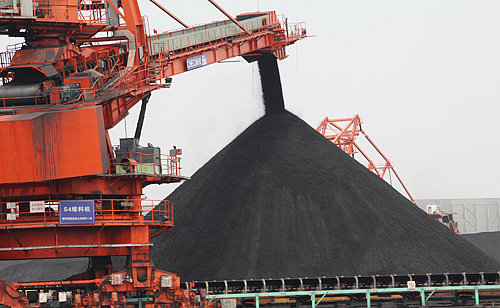|
 |
|
STOCKING UP: A machine loads coal on to a freighter in Huanghua Port, Hebei Province, which is bound to south China (FU XINCHUN) |
With the country entering the power consumption peak months, Chinese power companies are concerned about their ability to keep the nation powered.
According to Tan Rongyao, supervisor of the State Electricity Regulatory Commission, the electricity shortfall will hit 30 million kw, even higher than 2004 when China suffered the worst power shortage since the early 1990s. At that time, power cuts or limits were imposed in 27 provinces, municipalities and autonomous regions.
If the shortage of coal and insufficient hydraulic power generation continue, the power shortfall will peak 40 million kw, said Shuai Junqing, Vice President of the State Grid Corp. of China (SGCC), the country's leading power distributor.
In the past five years, China's total installed power capacity increased 445 million kw, but power shortages and blackouts have yet to be completely eliminated.
The last straw
Li Huiyong, a chief macroeconomic analyst for Shenyin & Wanguo Securities, said many factors contribute to China's power shortages.
"Around the year 2000, limited investments in the electric power industry led to the antiquation of the country's power generating facilities, which eventually triggered another round of power shortage in 2004," Li said. "China's power generation relies heavily on coal. Therefore, coal price increases erode electricity generation. From 2007 to 2008, coal price soared 300 percent, which caused a 15-percent hike in electric power price and directly triggered the electricity shortage in 2008."
As for the unprecedented power shortage this summer, Shuai blamed the electricity consumption boosted by the expansion of high energy-consumption and outdated industries. Figures of the National Bureau of Statistics show that in Zhejiang, the heavy industrial added value increased 13.7 percent year on year in the first quarter this year, while the electricity consumption of high energy-consuming sectors such as chemical and non-ferrous metal industries soared 20 percent year on year.
Shuai also claimed that the regional imbalance between the supply and demand of power has contributed to the power shortage. Economically developed coastal areas lack coal and power plants, but economically underdeveloped western and northern regions boast both. The weak trans-regional power transmission grid created a bottleneck in power transmission from northeast and northwest China to eastern and central parts of the country, said Shuai.
A survey conducted by Beijing-based daily Economic Information showed that the regional grid in the Inner Mongolia Autonomous Region had a surplus of 6.4 million kw in April. According to Lu Jian, Deputy Director of the Department of Development and Planning of SGCC, the northeast and northwest grids will have a surplus of 13 million kw and 14 million kw, respectively, this summer.
The problem lies in getting northwest and northeast China's power surplus to power-hungry central and east China, said Shuai.
Solutions
The battle against one of the most severe power shortages in China's history has seen central and local government bodies employ a variety of tactics. To boost power supplies, the National Development and Reform Commission (NDRC), China's top economic regulator, increased power prices for industrial users in 15 provinces, effective June 1. Residential power prices will remain unchanged.
| 